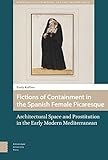Fictions of Containment in the Spanish Female Picaresque : Architectural Space and Prostitution in the Early Modern Mediterranean / Emily Kuffner.
Material type: TextSeries: Gendering the Late Medieval and Early Modern World ; 6Publisher: Amsterdam : Amsterdam University Press, [2019]Copyright date: ©2019Description: 1 online resource (240 p.)Content type:
TextSeries: Gendering the Late Medieval and Early Modern World ; 6Publisher: Amsterdam : Amsterdam University Press, [2019]Copyright date: ©2019Description: 1 online resource (240 p.)Content type: - 9789048538171
- Architecture in literature
- Picaresque literature, Spanish -- History and criticism
- Sex role in literature
- AUP Wetenschappelijk
- Amsterdam University Press
- Art and Material Culture
- Early Modern Studies
- Gender and Sexuality Studies
- History, Art History, and Archaeology
- LITERARY CRITICISM / European / Spanish & Portuguese
- prostitution, literature, early modern, sexuality, space
- 863.08709
- online - DeGruyter
| Item type | Current library | Call number | URL | Status | Notes | Barcode | |
|---|---|---|---|---|---|---|---|
 eBook
eBook
|
Biblioteca "Angelicum" Pont. Univ. S.Tommaso d'Aquino Nuvola online | online - DeGruyter (Browse shelf(Opens below)) | Online access | Not for loan (Accesso limitato) | Accesso per gli utenti autorizzati / Access for authorized users | (dgr)9789048538171 |
Browsing Biblioteca "Angelicum" Pont. Univ. S.Tommaso d'Aquino shelves, Shelving location: Nuvola online Close shelf browser (Hides shelf browser)
Frontmatter -- Table of Contents -- Introduction: Fictions of Containment -- 1. Prostitution in the Early Modern Spanish Mediterranean -- 2. Public Space and Public Women -- 3. Coaches of Deception: The Predatory Pícara -- 4. Prostitutes in the Window -- 5. The Doors of Paradise -- Conclusion -- Bibliography -- Index
restricted access online access with authorization star
http://purl.org/coar/access_right/c_16ec
This study examines the interdependence of gender, sexuality and space in the early modern period, which saw the inception of architecture as a discipline and gave rise to the first custodial institutions for women, including convents for reformed prostitutes. Meanwhile, conduct manuals established prescriptive mandates for female use of space, concentrating especially on the liminal spaces of the home. This work traces literary prostitution in the Spanish Mediterranean through the sixteenth and seventeenth centuries, from the rise of courtesan culture in several key areas through the shift from tolerance of prostitution toward repression. Kuffner’s analysis pairs canonical and noncanonical works of fiction with didactic writing, architectural treatises, and legal mandates, tying the literary practice of prostitution to increasing control over female sexuality during the Counter Reformation. By tracing erotic negotiations in the female picaresque novel from its origins through later manifestations, she demonstrates that even as societal attitudes towards prostitution shifted dramatically, a countervailing tendency to view prostitution as an essential part of the social fabric undergirds many representations of literary prostitutes. Kuffner’s analysis reveals that the semblance of domestic enclosure figures as a primary erotic strategy in female picaresque fiction, allowing readers to assess the variety of strategies used by authors to comment on the relationship between unruly female sexuality and social order.
Mode of access: Internet via World Wide Web.
In English.
Description based on online resource; title from PDF title page (publisher's Web site, viewed 25. Jun 2024)









